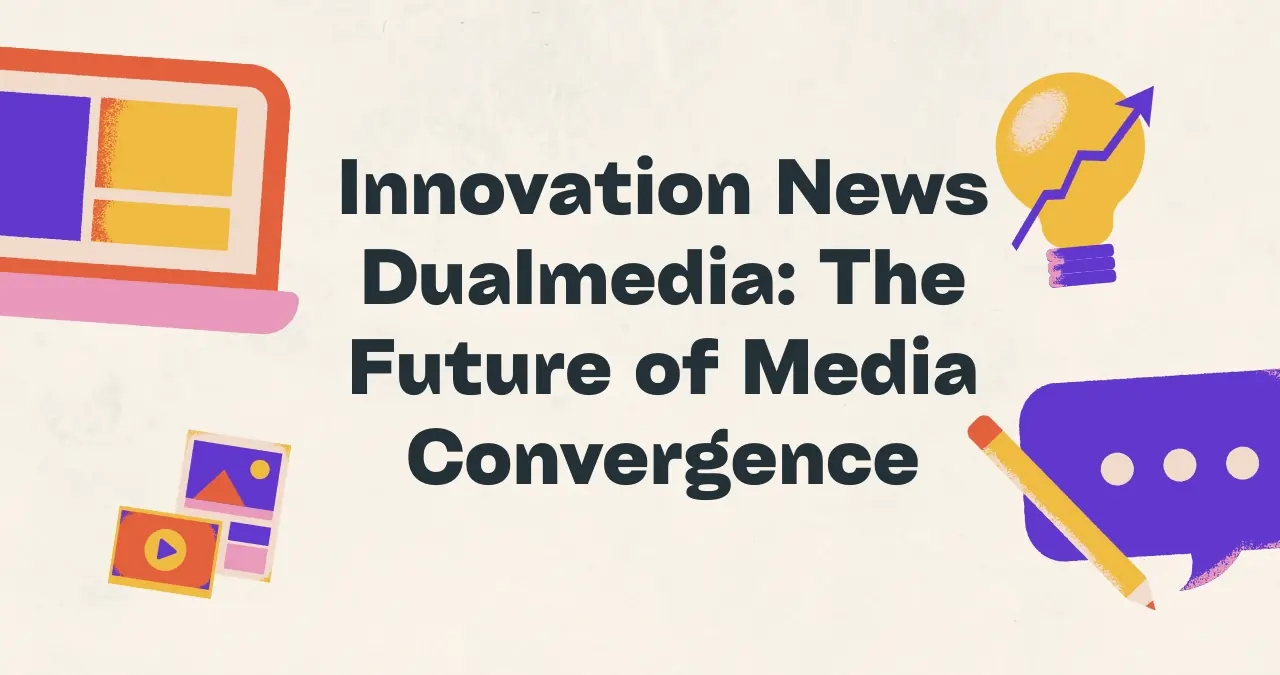Innovation News Dualmedia: The Future of Media Convergence

The media landscape is undergoing a seismic shift, and innovation news dualmedia is at the heart of this transformation. Dualmedia, the seamless integration of traditional and digital platforms, is redefining how stories are told and consumed. From interactive print editions to augmented reality-enhanced broadcasts, these advancements are creating richer, more engaging experiences for audiences.
This guide dives into the latest breakthroughs in dualmedia, exploring how they blend the tactile charm of traditional media with the dynamic potential of digital tools. Whether you’re a content creator or a curious consumer, here’s what you need to know about this exciting frontier.
What Is Dualmedia and Why It Matters
Dualmedia refers to the fusion of physical media—like print, radio, or television—with digital technologies such as apps, QR codes, or immersive web content. This convergence enhances accessibility, interactivity, and personalization. For example, a magazine might include scannable codes linking to video interviews, or a TV broadcast could sync with a mobile app for real-time polls. These innovations bridge the gap between passive consumption and active engagement, making dualmedia a game-changer for publishers, broadcasters, and audiences alike.
Key Trends in Dualmedia Innovation
The rapid pace of innovation news dualmedia reveals a range of exciting developments. Here are the most impactful trends reshaping the industry.
Augmented Reality in Print Media
Augmented reality (AR) is breathing new life into traditional print. By scanning a page with a smartphone, readers can unlock 3D visuals, animations, or interactive infographics. For instance, National Geographic uses AR to let readers explore virtual ecosystems within its magazines. This blend of tactile and digital enhances storytelling, making static content dynamic and memorable.
Interactive Broadcasting with Real-Time Integration
Television and radio are embracing digital interactivity. Platforms like Twitch and YouTube Live allow broadcasters to engage viewers through live chats and polls. Traditional outlets are following suit, with networks like BBC integrating apps that let audiences influence story arcs or access behind-the-scenes content. This real-time connection fosters a sense of community and keeps viewers hooked.
QR Codes Bridging Print and Digital
QR codes have surged in popularity, linking physical media to online content. Newspapers embed codes that lead to exclusive podcasts, while posters for events direct users to ticketing sites or virtual tours. This simple yet effective tool makes dualmedia accessible, requiring only a smartphone to unlock a wealth of digital experiences.
Technologies Powering Dualmedia Advancements
Behind these trends lie cutting-edge technologies that enable seamless media convergence.
Cloud-Based Content Management Systems
Cloud platforms like Adobe Experience Manager allow publishers to manage print and digital content in one ecosystem. Editors can update web stories and print layouts simultaneously, ensuring consistency across platforms. This streamlines workflows and supports rapid deployment of dualmedia campaigns.
AI-Driven Personalization
Artificial intelligence tailors content to individual preferences. For example, news apps analyze user behavior to recommend articles, while smart billboards adjust ads based on nearby smartphone data. In dualmedia, AI enhances both digital and traditional formats, creating hyper-relevant experiences that resonate with audiences.
5G for Seamless Connectivity
The rollout of 5G networks ensures fast, reliable access to digital content tied to physical media. Whether streaming AR visuals or participating in live broadcasts, 5G reduces latency and supports data-heavy applications. This infrastructure is critical for scaling dualmedia innovations globally.
Case Studies of Dualmedia Success
Real-world examples highlight the power of dualmedia in action.
- The New York Times’ AR Features: The NYT integrates AR into its print editions, letting readers scan articles to view 3D models or historical reenactments. This approach has boosted reader engagement and subscription rates.
- Spotify’s Music Magazines: Spotify partners with print publications to embed playlist QR codes, blending music discovery with editorial content. Readers scan to access curated tracks, merging physical reading with digital listening.
- CNN’s Interactive Broadcasts: CNN’s mobile app syncs with live TV, offering polls, fact-checking tools, and extended interviews. This dualmedia strategy has increased viewer retention and social media buzz.
Challenges and Opportunities in Dualmedia
While dualmedia offers immense potential, it faces hurdles. High development costs for AR or AI tools can strain budgets, especially for smaller publishers. Additionally, ensuring accessibility across devices and demographics requires careful design. However, these challenges present opportunities for innovation. Open-source AR frameworks and affordable cloud solutions are leveling the playing field, while inclusive design principles can broaden audience reach.
How Businesses Can Leverage Dualmedia
For media companies, dualmedia is a chance to stand out. Publishers can enhance print with digital extras, like scannable recipes in cookbooks or virtual tours in travel guides. Broadcasters can integrate apps to gamify viewing, rewarding users for participation. Advertisers benefit too, using QR codes or AR ads to drive engagement. The key is to prioritize user experience, ensuring digital enhancements complement, rather than overshadow, traditional formats.
Where to Follow Innovation News Dualmedia
Stay informed with resources like MediaTrendz, which covers dualmedia breakthroughs, or TechBit, a hub for AR and AI news. Industry conferences like CES and IBC showcase the latest tools, while X posts from thought leaders offer real-time insights. Engaging with these sources keeps you ahead of the curve in this fast-evolving field.
Conclusion
The rise of innovation news dualmedia marks a new era of storytelling, where traditional and digital media unite to captivate audiences. From AR-enhanced magazines to interactive broadcasts, these advancements offer endless possibilities for creators and consumers. By embracing technologies like AI, 5G, and cloud systems, businesses can craft immersive, personalized experiences that redefine engagement. Dive into the world of dualmedia, experiment with its tools, and discover how this convergence is shaping the future of media—one story at a time.
Explore More On This Topic: Calabash for Weight Loss: The Vitamin-Rich Fruit That Naturally Burns Fat






